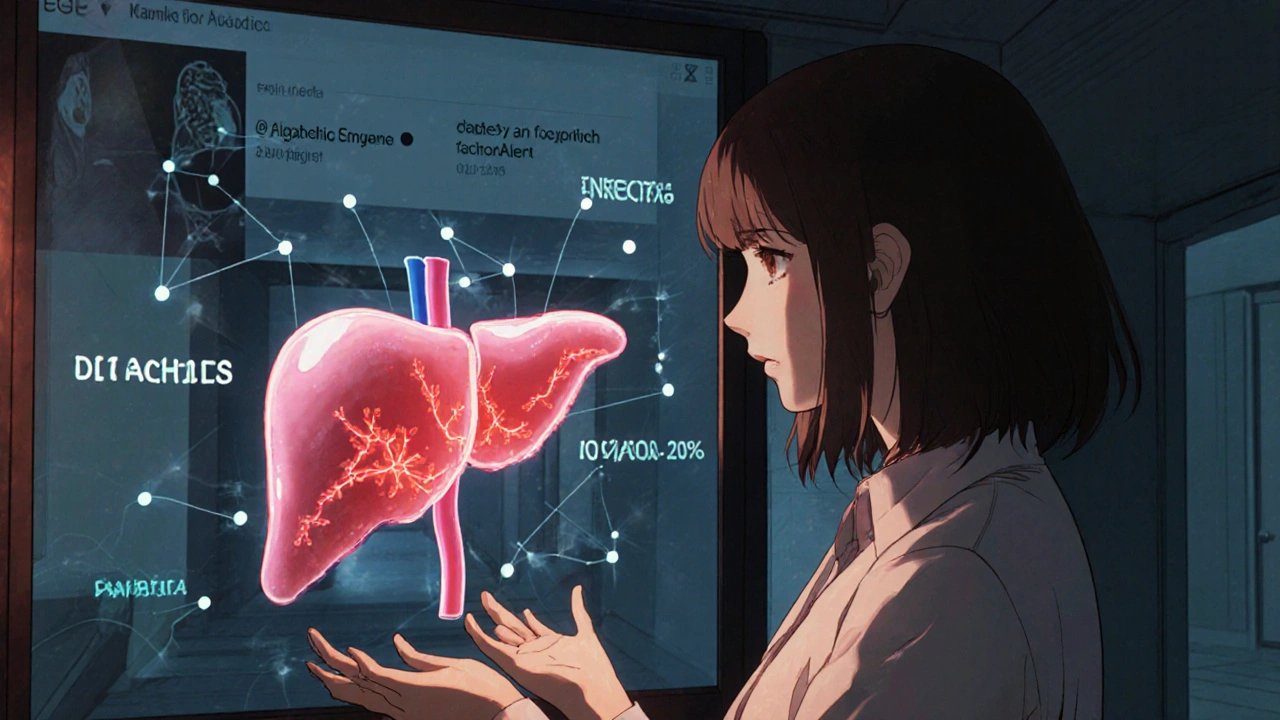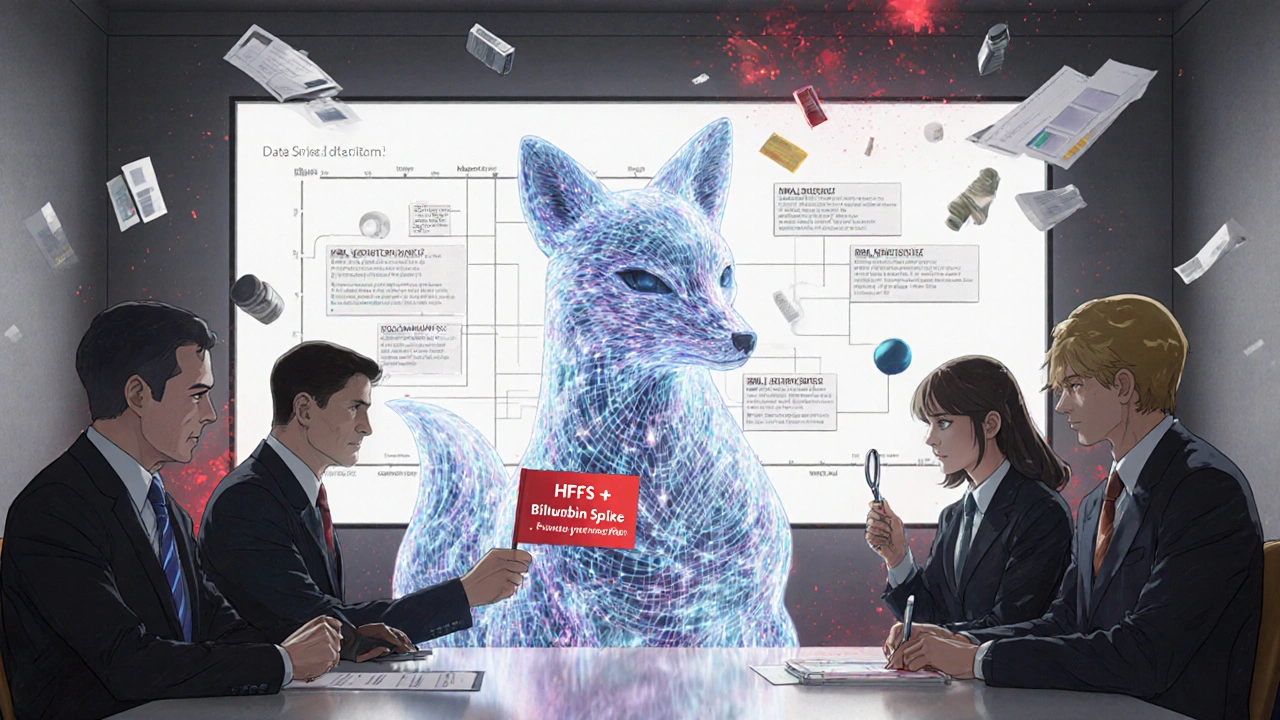Adverse Event Detection Comparison Tool
Traditional Methods
Traditional statistical approaches like Reporting Odds Ratio (ROR) and Information Component (IC).
Machine Learning
Advanced algorithms like Gradient Boosting Machines (GBM) and deep learning models.
Detection Comparison
Detection Improvement
Machine learning detects 51.1% more adverse events
From 13% to 64.1%
False Alarm Reduction
Machine learning reduces false alarms by 44.1%
From 80% to 35.9%
What This Means
For every 1,000 patients at risk, machine learning identifies 511 more adverse events than traditional methods, while generating 441 fewer false alarms.
Key Insight
Traditional methods miss about 87% of true adverse events requiring medical intervention. Machine learning catches about 64% of these high-risk cases.
For decades, drug safety monitoring relied on doctors and patients reporting side effects after the fact. If enough people reported the same unusual reaction-like sudden liver damage or unexplained heart rhythm changes-regulators would take notice. But this system was slow, noisy, and missed hidden patterns. Today, machine learning is changing that. Instead of waiting for reports to pile up, algorithms now scan millions of health records, insurance claims, and even social media posts to find early warning signs of dangerous drug reactions before they become widespread.
Why Traditional Methods Fall Short
The old way of spotting adverse events used statistical tools like Reporting Odds Ratio (ROR) and Information Component (IC). These methods looked at simple two-by-two tables: how many people took Drug X and had Side Effect Y, versus how many didn’t. Easy to understand, but deeply limited. They couldn’t account for age, other medications, pre-existing conditions, or timing. A patient on five drugs who developed a rash? The system couldn’t tell if it was Drug A, Drug C, or a combo. That’s why up to 80% of signals from traditional methods turned out to be false alarms. Worse, many real dangers slipped through. A 2024 study in JMIR found that conventional methods caught only 13% of adverse events that actually required medical intervention-like stopping a cancer drug or hospitalizing a patient. That means nearly nine out of ten life-threatening signals were missed. Meanwhile, machine learning models are now catching over 64% of those same high-risk events.How Machine Learning Finds Hidden Signals
Machine learning doesn’t just count. It learns. Algorithms like Gradient Boosting Machines (GBM) and Random Forest analyze hundreds of variables at once: patient demographics, lab results, prescription history, hospital admission dates, even the wording in doctor’s notes. They don’t rely on pre-set rules. Instead, they find patterns humans wouldn’t spot. Take the example of Hand-Foot Syndrome (HFS), a painful skin reaction linked to some cancer drugs. Researchers trained a deep learning model using data from the Korea Adverse Event Reporting System (KAERS), which included over 10 years of reports. The model didn’t just look for the term “rash.” It noticed that patients who had elevated bilirubin levels two weeks before their skin symptoms appeared were 4.3 times more likely to develop HFS. That’s a signal no human could have predicted from a simple report form. GBM models have shown accuracy rates of around 0.8 in distinguishing real adverse events from noise-comparable to the precision of prostate cancer screening tests. In one study, the MLSD framework detected 64.1% of signals requiring medical action, compared to 13% with traditional methods. Another model, AE-L, caught 46.4% of critical signals. These aren’t lab results. These are real-world validations from clinical databases.What Data Is Being Used?
Modern signal detection pulls from more than just government reporting systems. The FDA’s Sentinel System now integrates data from:- Electronic health records (EHRs) from 200+ hospitals and clinics
- Insurance claims databases covering 200 million patients
- Pharmacy dispensing records
- Patient registries for chronic diseases
- Social media posts and patient forums

Real-World Impact: When Detection Saves Lives
In 2022, researchers used machine learning to analyze data on infliximab, a drug used for Crohn’s disease and rheumatoid arthritis. The model flagged four known adverse events-like serious infections and heart failure-within the first year they appeared in the KAERS database. Traditional methods didn’t update the drug’s safety label until two years later. That’s a two-year gap where doctors and patients were unaware of the risk. Another case involved a new anti-cancer drug. Within weeks of launch, the GBM model detected a spike in liver enzyme elevations among patients over 70. The manufacturer was alerted. A targeted safety alert went out to oncologists. Dose adjustments were recommended. No deaths occurred. That’s the power of early detection. In clinical practice, when a machine learning system flags a signal, healthcare providers don’t always stop the drug. Most often, they adjust the dose, add monitoring, or educate patients. Only 4.2% of HFS signals led to treatment discontinuation. But catching those few cases early prevents hospitalizations and long-term damage.Challenges: The Black Box Problem
It’s not all smooth sailing. One major complaint from pharmacovigilance teams is the “black box” nature of deep learning models. If an algorithm says Drug X causes kidney failure, but it’s based on 300 hidden variables-some tied to weather patterns, others to hospital coding practices-it’s hard to explain to regulators or doctors why. This lack of interpretability is a barrier. Regulatory agencies like the EMA require transparency. They need to know not just that a signal exists, but why it’s credible. That’s why many teams now use hybrid models: a deep learning system finds the signal, then a simpler, explainable algorithm (like logistic regression) helps break down the key drivers. Data quality is another issue. If a hospital’s EHR system mislabels a side effect as “nausea” when it’s actually “vomiting with dehydration,” the model learns the wrong pattern. And not all countries share data openly. The U.S. and EU have robust systems. Many low- and middle-income countries still rely on paper reports.
Who’s Using This Today?
The adoption is accelerating fast. As of Q2 2024, 78% of the top 20 pharmaceutical companies have integrated machine learning into their pharmacovigilance operations, according to IQVIA. The global market for pharmacovigilance tech is projected to grow from $5.2 billion in 2023 to $12.7 billion by 2028. The FDA’s Sentinel System has completed over 250 safety analyses using ML since 2020. The EMA is preparing new guidelines-expected by late 2025-that will require companies to validate their AI models for bias, accuracy, and reproducibility before using them in regulatory submissions. Even small biotech firms are starting to use cloud-based ML platforms. Tools like OpenPharma’s SignalDetect and IBM’s Watson for Drug Safety now offer pre-built models trained on global safety data. You don’t need a team of data scientists to run them-just someone who understands drug safety workflows.What’s Next?
The next frontier is real-time detection. Imagine a system that flags a potential adverse event within hours of a patient’s first lab result showing abnormal liver enzymes-while they’re still in the clinic. That’s not science fiction. Pilot programs are already testing this using wearable data and continuous glucose monitors. Another trend: personalized risk scoring. Instead of saying “Drug Y causes liver damage,” models will soon say: “For a 68-year-old woman with type 2 diabetes and mild kidney impairment, Drug Y increases liver injury risk by 17%.” That kind of precision changes how doctors prescribe. Regulators are catching up too. The EMA’s upcoming GVP Module VI will set clear standards for validating ML models in drug safety. The FDA’s AI/ML Software as a Medical Device Action Plan is already guiding how these tools are approved.Should You Trust It?
Yes-but not blindly. Machine learning doesn’t replace human judgment. It enhances it. The best systems combine algorithmic power with clinical expertise. A model might flag a signal. A pharmacovigilance specialist reviews the context. A physician decides whether to act. The goal isn’t to automate safety. It’s to make it faster, smarter, and more proactive. For patients, that means fewer unexpected side effects. For doctors, fewer guesswork decisions. For drug makers, fewer recalls and lawsuits. The era of waiting for harm to happen is ending. With machine learning, we’re learning to see danger before it strikes.How accurate are machine learning models in detecting adverse drug reactions?
Current models using Gradient Boosting Machines (GBM) achieve accuracy rates of around 0.8, meaning they correctly identify true adverse events 80% of the time while filtering out false alarms. In clinical validation studies, these models detected 64.1% of adverse events requiring medical intervention, compared to just 13% using traditional statistical methods.
What data sources do machine learning systems use for signal detection?
Modern systems combine data from electronic health records, insurance claims, pharmacy dispensing logs, patient registries, and even social media and patient forums. The FDA’s Sentinel System, for example, integrates data from over 200 hospitals and 200 million patients. Multi-source validation helps reduce false positives and increases confidence in detected signals.
Can machine learning replace human pharmacovigilance experts?
No. Machine learning is a tool to augment human judgment, not replace it. Algorithms can scan millions of records and flag potential signals faster than any person, but only trained pharmacovigilance specialists can interpret the context, assess clinical relevance, and determine whether regulatory action is needed. The best systems combine AI efficiency with human expertise.
Why is model interpretability a challenge in this field?
Many powerful machine learning models, especially deep learning systems, work like “black boxes”-they identify patterns but don’t clearly explain why. Regulators and clinicians need to understand the reasoning behind a signal to trust it. That’s why hybrid approaches are growing: a complex model finds the signal, then a simpler, explainable model breaks down the key factors driving the prediction.
How long does it take to implement machine learning in a pharmacovigilance system?
Implementation varies. Large pharmaceutical companies typically take 18-24 months to fully integrate ML systems across global operations, including data integration, model validation, and staff training. Smaller organizations using cloud-based platforms can deploy pilot projects in 3-6 months. Pharmacovigilance professionals usually need 6-12 months of training to become proficient with these tools.
Are there regulatory guidelines for using AI in drug safety monitoring?
Yes. The U.S. FDA released its AI/ML Software as a Medical Device Action Plan in 2021, and the European Medicines Agency (EMA) is finalizing updated Good Pharmacovigilance Practices (GVP) Module VI, expected by Q4 2025. These guidelines require transparency, validation for bias, reproducibility, and ongoing monitoring of AI models used in safety assessments.



8 Comments
Sean Hwang
November 13, 2025 AT 23:48man i never thought my grandma's weird rash after her new meds would be picked up by some algorithm. but apparently it was. now they're warning docs about it before more people get messed up. kinda wild how tech is catching stuff we used to miss for years.
Barry Sanders
November 15, 2025 AT 14:3680% accuracy? lol. that's just noise with a fancy name. they're flagging coffee as a liver toxin next.
Chris Ashley
November 16, 2025 AT 17:56bro did you see that one guy on reddit who said his anxiety spiked after taking metformin? the model picked that up from a 3am post. now it's in the FDA's database. wild. we're living in sci-fi.
kshitij pandey
November 16, 2025 AT 18:04this is huge for places like India where reporting side effects is still paper-based and slow. if we can get these tools here, even with basic internet, we could save so many lives. no more waiting for 10 people to die before someone notices. thank you to the teams building this!
Brittany C
November 17, 2025 AT 12:59the real win here is the multi-modal validation framework-integrating EHRs, claims, and NLP-derived social media signals creates a robust signal-to-noise ratio that traditional ROR and IC metrics simply can't match. the 64.1% detection rate for clinically significant events is statistically compelling.
Sean Evans
November 18, 2025 AT 17:49lol they're letting AI decide who lives and dies now? 🤡 next they'll ban your meds if your Fitbit says you're stressed. this is dystopian bs. they don't even know why the model thinks your liver is failing-just trust the robot? 🤖💀
Anjan Patel
November 19, 2025 AT 21:10they're using social media posts? that's a joke. people lie online. someone says 'my head hurts' after taking ibuprofen-it could be a migraine, not a drug reaction. now we're gonna panic over every typo in a forum post? this is chaos. someone's gonna get sued because an AI misread 'tired' as 'toxic'.
Scarlett Walker
November 21, 2025 AT 17:35i work in a clinic and we just started using one of these ML tools. it flagged a patient's weird combo of meds that no one noticed-turned out she was getting liver stress from a cheap generic. we adjusted her script and she's fine now. it's not perfect, but it's like having a super-powered assistant who never sleeps. 🙌